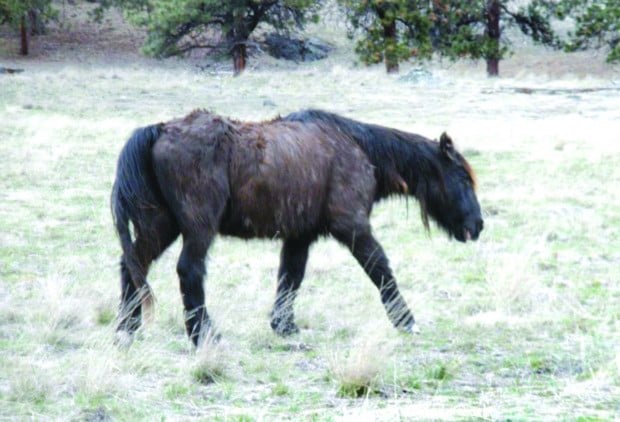This article sure is cool! I wish I could have a bite of the food this horse is eating to keep living! I hope he stays healthy and continues to live a long content life! ~Declan
Longevity of oldest resident of Wild Horse Island surprising
POLSON — This particular year-end update has become joyfully obligatory, and Jerry Sawyer seems to get a kick out of the annual phone call from the Missoulian.
His reports of the seemingly imminent demise of the oldest wild horse on Wild Horse Island again appear, Sawyer allows, to have been greatly exaggerated.
How the horse does it, he has no idea.
“He’s still going,” says Sawyer, who manages the seven state parks on Flathead Lake for Montana Fish, Wildlife and Parks. “One of our biologists was just doing a (bighorn) sheep count on the island, and he saw all the horses and said they were looking good. I don’t know what the old guy’s secret is, but whatever he’s eating, I wish I could get some.”
Sawyer had been predicting the old horse would likely not survive another winter for four or five winters now, and with good reason.
The last survivor of a 1992 transplant of wild horses onto the island has several times appeared to be days from a natural death’s door. Four years ago Sawyer said the ancient gelding ‘s ribs were clearly visible beneath his hide even though the island was lush with vegetation at the time.
It looked like the old boy’s internal organs were shutting down, Sawyer said back then.
There didn’t seem to be any way the old horse could ever survive another winter, and when he’d emerge intact — if little more than skin and bones — each successive spring, he sometimes looked like he might not even make it through one more summer.
He’s had difficulty shedding his winter coat every year for the past few, giving him an even more decrepit appearance. There has been an occasion or two over the past four to five years Sawyer has wondered aloud if the end might be just days away.
“Last spring, he looked more like a musk ox than a horse,” Sawyer says. “His metabolism isn’t what it needs to be, which is why he has trouble shedding his winter coat.”
Estimates for the lifespan of a wild horse go as low as 12 to 14 years, although others put it as high as 20 to 25.
The oldest wild horse on Wild Horse is at least 30.
“He’s got to be 30-plus,” Sawyer says. “That’s just ancient for a wild horse — like a human who lives over 100.”
The 2,164-acre island, 99 percent of which is a primitive state park, is managed under a plan that calls for up to five wild horses to call it home.
The horses, who share Wild Horse with hundreds of mule deer and bighorn sheep, are present solely to honor the island’s name.
In fact, the old horse was the only one left standing on Wild Horse in 2009 when FWP began restocking. So concerned was the agency that the last wild horse would die off over that winter and leave the island horse-less, it brought in a wild mustang on Christmas Eve of that year.
The following June four wild black mares — the first females ever transplanted to the island by FWP — were ferried over and released.
That meant when the sole survivor of the 1992 transplant did die of old age, Wild Horse Island State Park would have the five horses called for in the management plan.
But we all know what happens to the best-laid plans.
The island’s most senior of equine citizens just keeps on kicking, for one thing.
And no one knew that, when the four mares were released in 2010, one of them, as Sawyer explained, had been
“fiddling around” prior to the transplant.
She was already pregnant when she arrived on Wild Horse. No one but the horses witnessed the birth of the foal, a pretty little Paint. So one day, as Sawyer put it back then, the population of wild horses on Wild Horse was six, and the next time anyone counted it was, in his words, “6½.”
Is it possible the influx of new blood on the island has helped keep its oldest resident alive just by providing companionship?
“I’m not a horse psychologist,” Sawyer says. “I’d like to say so. It’s one of those feel-good things. If you start putting human attributes on animals, though, there are going to be some biologists who shudder.”
Authorities speculate a mountain lion may have taken up residence on the island in recent months and is hunting deer and sheep, Sawyer says. While such a predator might also be tempted go after one lone sickly horse, it won’t waste its time chasing a mostly healthy herd of seven, so in that respect, all the relatively recent arrivals have probably helped the old horse’s longevity, according to Sawyer.
“But I have to say I personally believe it’s helped” in more ways than that, Sawyer admits. “I don’t know how a horse’s brain operates, but they are social animals.”
And he’s done predicting the old horse’s days are numbered.
When asked if he thinks the wild horse population on Wild Horse Island will still be seven when we check again next year, Sawyer now says, “You know, if we have another mild winter, he just might make it.”

No comments:
Post a Comment